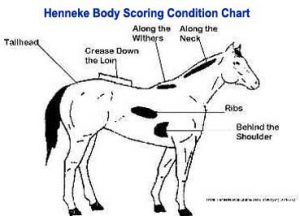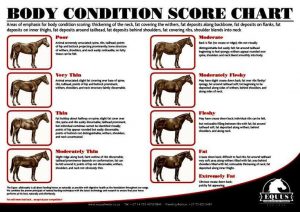Gauging the Weight of Our Horses
While we don’t all have access to a large enough scale to gauge the weights of our horses, we all have the ability to become experts in body condition scoring. I will first mention that this system of scoring is built off of some basic guidelines but is largely subjective. The way in which you score a particular horse might vary from the score given by a friend. That’s okay; just remain consistent in your scoring.
The scoring system is often referred to as the Henneke Body Condition Score, derived from Don Henneke out of Texas A&M University in the 1980s. The goal was to create a universal scale to evaluate the body condition of horses that worked across different breeds. The only necessary tools to use this standard is a set of eyes and a hand for palpation. The scale is built on a range from 1-9, with 1 being extremely emaciated and 9 being extremely obese. A score of 5 is ideal when talking horses, moderately fleshy, not too poor or too fat. Personally, I like to know what a score of 5 looks like to me and I always start there when I am looking at a horse to score. If you can picture what is ideal, you can more easily decipher if a horse falls in a score above or below ideal.
The Six-Point Scoring System

This system hones in on six points of the horse to assess overall condition: neck, withers, shoulders, ribs, loins, and tail head. These areas can be visually or physically palpated to estimate the fat coverage. As horse people, we know there is major variation in body composition from breed to breed or between disciplines. For example, a miniature horse is often predisposed to depositing fat in those six areas (among many others) at a greater rate than say an off the track Thoroughbred, a high energy, high withered, lankier animal. A score of 5 for both of the aforementioned animals might look slightly different, but respectively will be ideal for that type of horse.
On that same note, depending on what is asked of a horse, a score of 4 or 6 is absolutely acceptable. Take a trip to a commercial race horse facility and you will see some of the best equine athletes that resemble that of an elite human track star, very lean and muscled, with minimal fat. This does not mean these horses are skinny or unhealthy, but that they are fitted for the extreme exertion that is asked of them. To the contrary, horse owners like to “kill their horse with kindness” sometimes by overfeeding and loving them through treats and excess meals. This often results in a body condition of 7 and above and can be just as deteriorating to the overall health of a horse as a malnourished horse.
Know What is Normal for your Horse
The best way to monitor your horse’s condition is to know what is normal for your horse. What type of work is that horse being asked to perform and is it genetically predisposed to being lean or an easy keeper? Then you can construct a management protocol to meet the nutrient and exercise requirements that will maintain your horse at an ideal condition. See the graphics included here to develop a sense of the six points and the variation of fat cover that should be present.

Re-evaluating body condition scores is helpful to track progress of rescued animals or those getting back into working condition. This scale is also very useful in pregnant mares and foals. A large belly due to pregnancy does not necessarily mean that the mare is at a body condition score of 5. Be aware of the other score points for a more accurate account of overall condition.
If you would like to receive more hands-on practice and information with regards to body condition scoring be sure to contact your local livestock extension agent. If you’re in Marion County, that is me! My office number is 352-671-8400, or email me at cbainum@ufl.edu.
 0
0
